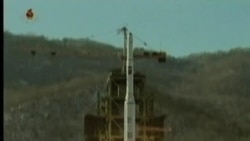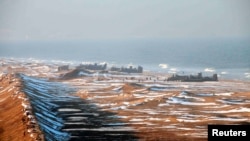SEOUL —
North Korea says it has put its rocket units on the highest combat readiness level. The announcement includes fresh threats to strike U.S. military bases and South Korea.
The official North Korean news agency and state radio Tuesday afternoon carried the latest announcement from the army's supreme command that all field artillery units, including those armed with strategic rockets and long-range artillery, are now at the top level of "combat-ready posture."
The announcer reading the military's statement on the central broadcasting station in Pyongyang declared the units "will target all enemy objects in U.S. offensive bases on its mainland, Hawaii and Guam."
The targets, according to the broadcast, also include South Korea, with the warning that at first shot "everything will be blown away and turned to ash."
South Korea’s Ministry of National Defense says this is the first time Pyongyang's military has ever publicly referred to an “il-ho” – or number one – combat readiness alert.
It is the latest in an escalating round of bellicose rhetoric from the North, which has included a threat to conduct a preemptive nuclear strike on the United States.
The command issued to the rocket units comes days after the U.S. air force flew B-52 sorties over the peninsula as part of an annual joint drill with South Korean forces. And it comes just hours after South Korean President Park Geun-hye said it is time for North Korea to change for its own sake.
The president, speaking at the national cemetery in Daejeon, says "the only way North Korea will survive is if it voluntarily lays down its nuclear weapons, missiles, provocations and threats, and transforms into a responsible member of the international community."
The speech was part of a memorial marking the March 26, 2010 sinking of a South Korean coastal warship that killed 46 sailors.
South Korea and others who joined a multinational investigation into the explosion on the Cheonan in the Yellow Sea concluded the ship was hit by a North Korean torpedo. Pyongyang has denied carrying out the attack.
Related video report by Jeff Custer In a letter to soldiers marking the anniversary of the Cheonan's sinking, Defense Minister Kim Kwan-jin requested the military stay on high alert so it can immediately retaliate should there be another North Korean attack.
As the solemn observance was taking place in the South, military maneuvers were apparently underway in the North. But there has been no indication any attack is imminent.
Wee Yong-sub is a spokesman for South Korea's Ministry of National Defense.
Wee says there appears to be a state-level military drill underway with amphibious landings and counter-landing operations conducted by North Korea's navy and army.
A three-year war fought by the two Koreas in the early 1950's ended in a stalemate. A peace treaty was never signed.
Two weeks ago, Pyongyang declared the 1953 war truce invalid. The U.S.-led U.N. command says the document remains in effect and that no one party to the armistice can abrogate it.
The official North Korean news agency and state radio Tuesday afternoon carried the latest announcement from the army's supreme command that all field artillery units, including those armed with strategic rockets and long-range artillery, are now at the top level of "combat-ready posture."
The announcer reading the military's statement on the central broadcasting station in Pyongyang declared the units "will target all enemy objects in U.S. offensive bases on its mainland, Hawaii and Guam."
The targets, according to the broadcast, also include South Korea, with the warning that at first shot "everything will be blown away and turned to ash."
South Korea’s Ministry of National Defense says this is the first time Pyongyang's military has ever publicly referred to an “il-ho” – or number one – combat readiness alert.
It is the latest in an escalating round of bellicose rhetoric from the North, which has included a threat to conduct a preemptive nuclear strike on the United States.
The command issued to the rocket units comes days after the U.S. air force flew B-52 sorties over the peninsula as part of an annual joint drill with South Korean forces. And it comes just hours after South Korean President Park Geun-hye said it is time for North Korea to change for its own sake.
The president, speaking at the national cemetery in Daejeon, says "the only way North Korea will survive is if it voluntarily lays down its nuclear weapons, missiles, provocations and threats, and transforms into a responsible member of the international community."
The speech was part of a memorial marking the March 26, 2010 sinking of a South Korean coastal warship that killed 46 sailors.
South Korea and others who joined a multinational investigation into the explosion on the Cheonan in the Yellow Sea concluded the ship was hit by a North Korean torpedo. Pyongyang has denied carrying out the attack.
Related video report by Jeff Custer In a letter to soldiers marking the anniversary of the Cheonan's sinking, Defense Minister Kim Kwan-jin requested the military stay on high alert so it can immediately retaliate should there be another North Korean attack.
As the solemn observance was taking place in the South, military maneuvers were apparently underway in the North. But there has been no indication any attack is imminent.
Wee Yong-sub is a spokesman for South Korea's Ministry of National Defense.
Wee says there appears to be a state-level military drill underway with amphibious landings and counter-landing operations conducted by North Korea's navy and army.
A three-year war fought by the two Koreas in the early 1950's ended in a stalemate. A peace treaty was never signed.
Two weeks ago, Pyongyang declared the 1953 war truce invalid. The U.S.-led U.N. command says the document remains in effect and that no one party to the armistice can abrogate it.











